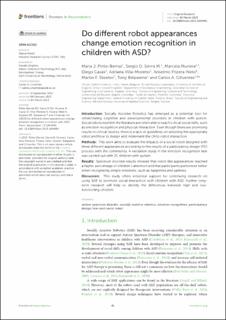| dc.contributor.author | Pinto-Bernal, Maria J. | |
| dc.contributor.author | Sierra M, Sergio D. | |
| dc.contributor.author | Munera, Marcela | |
| dc.contributor.author | Casas, Diego | |
| dc.contributor.author | Villa-Moreno, Adriana | |
| dc.contributor.author | Frizera-Neto, Anselmo | |
| dc.contributor.author | Stølen, Martin F | |
| dc.contributor.author | Belpaeme, Tony | |
| dc.contributor.author | Cifuentes, Carlos A. | |
| dc.date.accessioned | 2023-09-08T08:16:43Z | |
| dc.date.available | 2023-09-08T08:16:43Z | |
| dc.date.created | 2023-05-16T14:25:53Z | |
| dc.date.issued | 2023 | |
| dc.identifier.citation | Frontiers in Neurorobotics. 2023, 17 . | en_US |
| dc.identifier.issn | 1662-5218 | |
| dc.identifier.uri | https://hdl.handle.net/11250/3088125 | |
| dc.description.abstract | Introduction: Socially Assistive Robotics has emerged as a potential tool for rehabilitating cognitive and developmental disorders in children with autism. Social robots found in the literature are often able to teach critical social skills, such as emotion recognition and physical interaction. Even though there are promising results in clinical studies, there is a lack of guidelines on selecting the appropriate robot and how to design and implement the child-robot interaction. Methods: This work aims to evaluate the impacts of a social robot designed with three different appearances according to the results of a participatory design (PD) process with the community. A validation study in the emotion recognition task was carried out with 21 children with autism. Results: Spectrum disorder results showed that robot-like appearances reached a higher percentage of children's attention and that participants performed better when recognizing simple emotions, such as happiness and sadness. Discussion: This study offers empirical support for continuing research on using SAR to promote social interaction with children with ASD. Further long-term research will help to identify the differences between high and low-functioning children. | en_US |
| dc.language.iso | eng | en_US |
| dc.publisher | Frontiers | en_US |
| dc.rights | Navngivelse 4.0 Internasjonal | * |
| dc.rights.uri | http://creativecommons.org/licenses/by/4.0/deed.no | * |
| dc.title | Do different robot appearances change emotion recognition in children with ASD? | en_US |
| dc.type | Peer reviewed | en_US |
| dc.type | Journal article | en_US |
| dc.description.version | publishedVersion | en_US |
| dc.rights.holder | © 2023 Pinto-Bernal, Sierra M, Munera, Casas, Villa-Moreno, Frizera-Neto, Stoelen, Belpaeme and Cifuentes | en_US |
| dc.source.pagenumber | 11 | en_US |
| dc.source.volume | 17 | en_US |
| dc.source.journal | Frontiers in Neurorobotics | en_US |
| dc.identifier.doi | 10.3389/fnbot.2023.1044491 | |
| dc.identifier.cristin | 2147866 | |
| cristin.ispublished | true | |
| cristin.fulltext | original | |
| cristin.qualitycode | 1 | |

